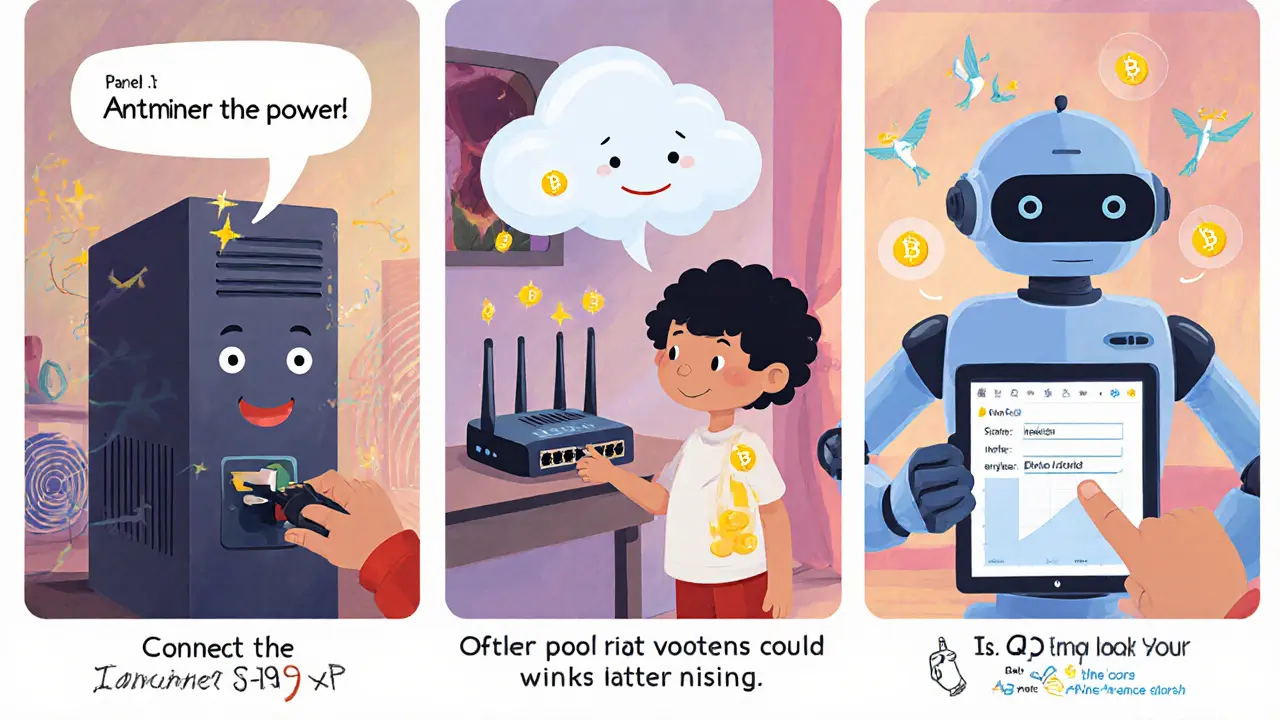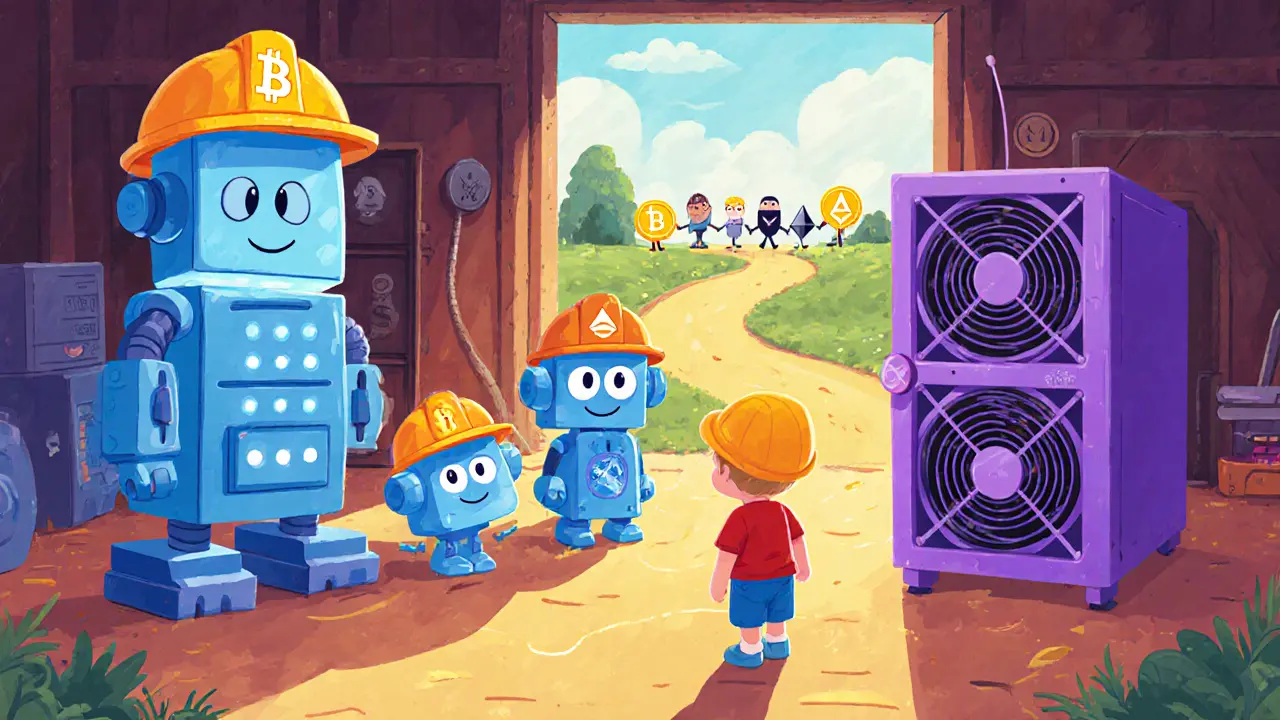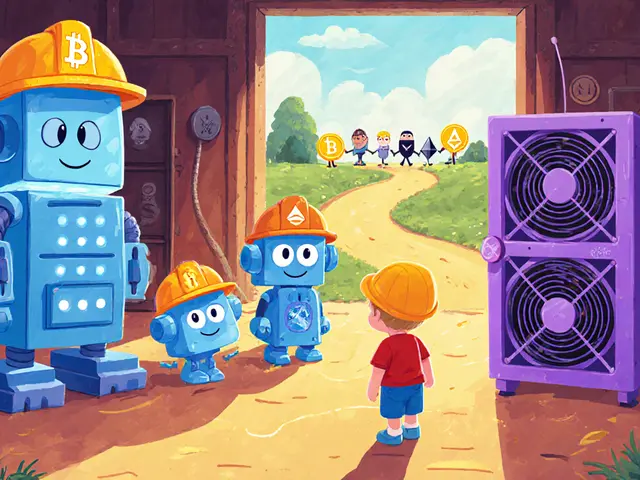Mining Profitability Calculator
Estimated Daily Profit
Coin Information
Bitcoin
ASIC required. Block time: 10 mins.
Litecoin
Scrypt ASICs. Block time: 2.5 mins.
Monero
CPU/GPU friendly. Block time: 2 mins.
Ethereum Classic
GPU miners. Block time: ~12 sec.
If you’re trying to decide where to put your hash power this year, the answer isn’t simple. The Bitcoin network’s fourth halving in April 2024 slashed block rewards, turning the mining landscape into a high‑stakes arena for big farms. At the same time, a handful of altcoins still let hobbyists crank out coins with a single GPU or a modest ASIC. This guide walks you through the major differences, breaks down the numbers for 2025, and helps you figure out which side of the fence fits your budget, skill level, and risk appetite.
Quick Take
- Bitcoin mining now demands ASICs, $10k‑$100k upfront, and electricity below $0.07/kWh to break even.
- Litecoin offers a cheaper ASIC entry point and 2.5‑minute blocks, making daily payouts smoother.
- Monero can be mined on standard CPUs/GPUs, ideal for low‑cost setups, but price volatility is higher.
- Profitability hinges more on energy costs and hardware efficiency than on coin price alone.
- Join a mining pool for any coin if you want steady cash flow; solo mining is rare for most miners.
Understanding the Basics
Before you compare numbers, know what each term means.
Bitcoin is a decentralized digital currency that uses a Proof‑of‑Work (PoW) consensus algorithm. Miners solve cryptographic puzzles every 10 minutes, earning newly‑minted BTC and transaction fees.
Litecoin was created as a lighter version of Bitcoin. It also uses PoW but with a 2.5‑minute block time and the Scrypt algorithm, which makes it compatible with less expensive ASICs.
Monero focuses on privacy. Its RandomX PoW algorithm is deliberately CPU/GPU‑friendly, preventing ASIC dominance.
Ethereum Classic retains the original Ethereum PoW chain, accessible to GPU miners after Ethereum’s switch to Proof‑of‑Stake.
Technical Requirements in 2025
The hardware you need decides how much you’ll spend before you even think about electricity.
ASIC (Application‑Specific Integrated Circuit) devices are built for a single algorithm. For Bitcoin they are the only viable option; models like the Antminer S19 XP or Whatsminer M30S++ deliver 140‑200 TH/s at 30‑35J/TH.
GPU (Graphics Processing Unit) rigs stay relevant for coins like Monero and Ethereum Classic. A modern RTX 4090 can hash around 30kH/s on RandomX while drawing about 350W.
Other essential pieces:
- Mining pool: pools such as Slush Pool (Bitcoin) or SupportXMR (Monero) combine many miners’ work and split rewards.
- Halving: Bitcoin’s block reward halves every 210,000 blocks (≈4years). The 2024 event dropped the reward to 3.125BTC, reducing revenue per hash.
- Hash rate: The total computing power protecting a network. Bitcoin’s global hash rate topped 350EH/s in 2025, while Litecoin sat near 15TH/s and Monero around 2.5GH/s.
- Electricity cost: The biggest ongoing expense. Most profitable Bitcoin farms secure rates under $0.07/kWh; altcoin miners can survive at $0.10‑$0.12/kWh depending on the coin.
Profitability Comparison (2025)
| Coin | Typical Hardware | Hash Power (per unit) | Power Consumption | Electricity Rate | Daily Profit* |
|---|---|---|---|---|---|
| Bitcoin | Antminer S19 XP | 140TH/s | 30W/TH | $0.07/kWh | $12.40 |
| Litecoin | Goldshell LT6 | 2.5TH/s (Scrypt) | 2kW | $0.08/kWh | $8.30 |
| Monero | RTX 4090 (GPU) | 30kH/s (RandomX) | 0.35kW | $0.12/kWh | $5.90 |
| Ethereum Classic | RTX 3080 (GPU) | 88MH/s (Ethash) | 0.32kW | $0.11/kWh | $6.20 |
*Profits calculated using average network difficulty and coin prices in September2025. Real‑world results vary with local electricity rates, pool fees, and hardware depreciation.

Risk & Volatility Factors
Profitability isn’t just a static spreadsheet; several moving parts can flip the script.
- Price swings: Bitcoin’s price has moved between $55k‑$60k this year, while Monero has bounced 30% up or down within weeks. A sudden dip can push a marginally profitable operation into loss.
- Difficulty adjustments: All PoW networks retarget every 2016 blocks (≈2weeks for Bitcoin, 1day for Litecoin). A sudden influx of miners spikes difficulty and shrinks rewards.
- Regulatory climate: Some jurisdictions have tightened mining rules, affecting electricity tariffs or even banning certain hardware.
- Hardware lifespan: ASICs lose efficiency as newer models arrive. A two‑year old S19 XP may be out‑performed by a newer S19 Pro, forcing early replacement.
Step‑by‑Step Setup Guides
1. Bitcoin ASIC Mining
- Purchase a compatible ASIC (e.g., Antminer S19 XP) and a reliable power supply unit (PSU) rated for the device’s wattage.
- Choose a location with adequate cooling-ideally 18‑22°C-and ensure the electrical circuit can handle the load (30A+circuit breaker).
- Connect the ASIC to your router via Ethernet; avoid Wi‑Fi for stability.
- Create an account on a Bitcoin mining pool (e.g., Slush Pool) and copy the pool’s URL and your worker credentials.
- Access the ASIC’s web interface (usually http://device‑ip:4028), enter the pool URL, username, and password. Save settings.
- Power on the device, monitor hash rate and temperature for the first 24hours, and adjust fan speeds if needed.
2. Litecoin Scrypt ASIC Mining
- Buy a Goldshell LT6 or similar Scrypt ASIC; power requirements are lower than Bitcoin ASICs.
- Set up a basic cooling solution-small inline fans are often sufficient.
- Register on a Litecoin pool such as Litecoinpool.org, copy the Stratum URL.
- Enter the pool URL and your worker name in the ASIC’s configuration page and start mining.
- Track daily payouts; the shorter 2.5‑minute blocks give you more frequent confirmations.
3. Monero CPU/GPU Mining
- Download the latest version of XMRig (CPU) or XMRig-CPU-GPU (GPU).
- Choose a pool like SupportXMR; note the port number for the RandomX algorithm.
- Edit the config.json file: set "url" to the pool address, "user" to your Monero wallet, and "pass" to "x".
- Run the miner via command line; watch the hash rate (kH/s) and adjust CPU threads or GPU intensity for optimal performance.
- Because Monero rewards are paid every block (~2minutes), you’ll see payouts on your wallet almost instantly after crossing the pool’s minimum payout threshold.
Decision Framework: When to Choose Which Coin
Use the checklist below to match your situation with the right mining path.
- Capital available: <$5k - start with Monero or a low‑cost GPU rig.
$5k‑$20k - consider a Litecoint Scrypt ASIC.
>$20k - Bitcoin ASIC farm becomes viable. - Electricity rates: < $0.06/kWh - Bitcoin ASICs can break even.
$0.07‑$0.10/kWh - Litecoint or Monero mining is more realistic.
>$0.10/kWh - look for renewable‑energy deals or relocate. - Technical expertise: No experience - start with a plug‑and‑play ASIC kit (Litecoin) or a pre‑configured GPU miner (Monero).
Comfortable with networking and cooling - go full‑scale Bitcoin. - Risk tolerance: Want steady, long‑term returns? Bitcoin’s market depth offers that, but entry costs are high.
Prefer faster cash flow and can tolerate price swings? Altcoins give quicker payouts.
In practice, many miners diversify: a small GPU rig for Monero to test the waters while a separate ASIC box handles Bitcoin or Litecoin for steady income.
Key Takeaways
In 2025 the mining decision hinges on three pillars:
- Energy efficiency: Secure the lowest possible kWh rate.
- Hardware suitability: Match algorithm to device (ASIC for Bitcoin, GPU/CPU for Monero).
- Market dynamics: Track coin price, network difficulty, and upcoming protocol changes.
By aligning your budget, electricity cost, and technical skill with these pillars, you can choose the coin that maximizes profit while keeping risk in check.
Frequently Asked Questions
Is Bitcoin mining still profitable in 2025?
Profitability now depends heavily on electricity costs and hardware efficiency. With rates below $0.07/kWh and a modern ASIC like the Antminer S19XP, miners can still earn a positive margin, but small operators without bulk power deals will struggle.
Can I mine Monero with a laptop?
Technically yes, but a laptop’s CPU will generate only a few H/s and consume the same power, resulting in negligible profit. A desktop GPU or a low‑cost CPU rig gives a far better return.
What’s the advantage of Litecoin’s merged mining with Dogecoin?
Merged mining lets a single ASIC submit work to both Litecoin and Dogecoin simultaneously, splitting rewards from both chains. This boosts overall revenue without extra hardware, effectively raising daily profit by 10‑15%.
How often does network difficulty adjust for these coins?
Bitcoin retargets every 2016 blocks (~2weeks). Litecoin adjusts every 2016 blocks as well, but because blocks are faster, the adjustment occurs about every 3.5days. Monero retargets every block, making its difficulty highly responsive to hash‑rate changes.
Should I join multiple mining pools?
Diversifying across pools can hedge against a single pool’s downtime or high fees. However, managing multiple payouts adds complexity. Most miners stick with one reputable pool per coin to keep accounting simple.


Cyndy Mcquiston
October 4, 2025 AT 10:15Bitcoin is the only real crypto. Everything else is just noise. If you're not mining BTC with ASICs, you're wasting your time and electricity.
Abby Gonzales Hoffman
October 4, 2025 AT 14:29I started with a used RTX 3060 mining Monero last year and made back my $300 in 4 months. Electricity here is $0.11/kWh but RandomX is so efficient it still nets me $4/day. Don't write off GPU mining just because Bitcoin's flashy. Small setups can thrive.
Rampraveen Rani
October 5, 2025 AT 10:18Litecoin + Dogecoin merged mining is pure genius 😎 I got a Goldshell LT6 for $800 and now I'm earning from two coins at once. Payouts every few hours, no stress. Bitcoin ASICs? Too much money locked up for me 🤷♂️
ashish ramani
October 6, 2025 AT 00:02The table shows daily profits but ignores hardware depreciation. An S19 XP loses 20% of its value per year. Factoring that in, altcoins often have better ROI over 18-24 months.
Natasha Nelson
October 6, 2025 AT 09:00I just tried mining Monero on my old Ryzen 5... it was so slow, and my electric bill went up by $18 that month. I felt so silly. Don't mine with a laptop. Seriously. Just don't.
Sarah Hannay
October 7, 2025 AT 06:24While the technical specifications presented are accurate, one must also consider the broader ethical and environmental implications of proof-of-work mining. The energy consumption of Bitcoin alone exceeds that of entire nations. A responsible investor should weigh profitability against ecological responsibility, even if the numbers appear favorable on paper.
Richard Williams
October 7, 2025 AT 06:30If you're new and unsure where to start, here's what worked for me: Buy a $400 used Litecoin ASIC, plug it in, join Litecoinpool.org, and let it run for 30 days. If you break even, scale up. If not, you lost less than a new phone. No PhD needed. Just start small, learn fast, and don't overthink it.